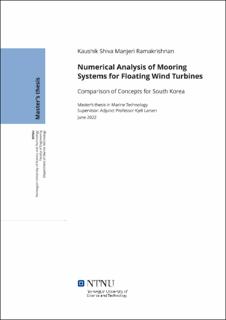| dc.description.abstract | The world is progressing rapidly towards sustainable forms of energy, and the share of electrical energy produced from wind will grow exponentially in the coming years. Subsequently, floating wind turbines are moving towards deeper water depths greater than 100 m. A significant challenge in deep water floating wind turbines is the increasing cost compared to bottom-fixed wind turbines. A vital contribution to the cost is that of the mooring system. Therefore, novel solutions are required to design and optimise the mooring system to reduce its cost. As a part of this thesis, different types of mooring systems for a floating wind turbine are studied. The design standards and various load cases relevant to the ultimate limit state design of the mooring system are also discussed.
A floating structure at sea is subjected to wind, wave, and current loads. These are discussed in detail with the equation of motion for a floating wind turbine. Different types of analysis performed on a mooring system are also discussed, emphasising the time-domain approach. Some dynamic instabilities observed in floating wind turbines are also discussed.
The INO WINDMOOR 12MW floating wind turbine with a semi-submersible substructure to be deployed at 100 m water depth off the coast of South Korea is analysed in this thesis. The analysis is carried out using the SIMA software package. The existing mooring system for the wind turbine designed by Inocean is replaced by a mooring system suitable for 100 m water depth with three mooring lines consisting of pure chain elements. A SIMO model with this mooring system serves as the base case system in this thesis. In addition to this, hybrid mooring systems such as Chain-Polyester-Chain system, Chain-Polyester-Chain system Clump Weights and Chain-Nylon-Chain systems are also analysed using a coupled SIMO-RIFLEX model to develop a cost-effective novel alternative for deep water mooring of floating wind turbine.
To document the model’s behavior, identification tests such as constant wind tests, pull out and decay tests, and regular wave tests were performed. Furthermore, time-domain analysis was performed to ensure compliance with the ultimate limit state design for the various mooring concepts. According to the time-domain analysis, the hybrid mooring system shows great promise and can be used for floating offshore wind turbines. | |
